 Coins of Diocletian, Roman emperor 284-305 and founder of the First Tetrarchy
Coins of Diocletian, Roman emperor 284-305 and founder of the First Tetrarchy  Coins of Diocletian, Roman emperor 284-305 and founder of the First Tetrarchy
Coins of Diocletian, Roman emperor 284-305 and founder of the First Tetrarchy
Diocletian became the Roman emperor ("Augustus") in the east in 284 CE and ruled until his abdication in 305. He promoted Maximian to co-Augustus in 286. In 293 he added two Caesars, Constantius and Galerius, making four simultaneous rulers, that is, a "tetrarchy." For a page devoted to the coinage of the First Tetrarchy, see here. For a short history of Diocletian see below on this page.
Coin to the right: A large (28 mm) follis of Diocletian. IMP[erator] DIOCLETIANVS AVG[ustus]. His laureate and cuirassed bust right. Details of the coin are below. His full name was Gaius Aurelius Valerius Diocletianus. His coins usually just name him DIOCLETIANVS, but sometimes include "C C VAL" for Caesar Gaius Valerius.
Events that significantly changed the coins of Diocletian are listed next and linked to coins illustrated below on this page.
1) 284. Diocletian became Augustus and began issuing radiate coins (called aureliani or antoniniani) much like those of previous emperors. (This page does not discuss his gold coins.)
2) 286. Diocletian promoted Maximian to co-emperor in the west. Reverse legends that ended "AVG" changed to end "AVGG."
3) 293. Promoted Constantius and Galerius to Caesars in the west and east, respectively. Coins in their names were added, but coins in the name of Diocletian did not change.
4) c. 294. Began a coin reform that changed the denominational system, adding in the follis (a.k.a. nummus), silver argenteus, and (in the east) the "radiate fraction" (a.k.a. Post-reform radiate) that had the appearance of, but less silver than, the previous radiates. Production of the previous radiates was discontined
5) 296-7. Maximian went to North Africa to quell a rebellion and opened the Carthage mint which minted reverse types unique to Carthage.
6) 298. Trier (only Trier) minted FORTVNA REDVCI types for the safe return of emperors from their travels.
7) 300. In 300 concerns about inflation prompted a new type--the SACRA MONETA type--which was introduced to emphasize the sacred nature of coinage and its value. In 301 Diocletian issued a Currency Edict and the "Edict on Maximum Prices" to dictate prices. Apparently the nominal values of some of the existing denominations were changed, but little is visible in the coinage other than the new SACRA MONETA type.
8) 305. Diocletian and Maximian retired May 1, 305. Retirement/abdication types began.
9) c. 308. Retirement issues for Diocletian were discontinued.
This page ends with some other types. References are at the end.
Event 1) Diocletian issued aureliani which were often marked XXI to denoted 20 parts copper and 1 part silver. They come with very many different reverse legends and designs. A page devoted to aureliani of Diocletian is here.
![]() Diocletian
Diocletian
23-22 mm. 3.93 grams.
IMP DIOCLETIANVS AVG
IOVI CONSERVAT AVG
XXIΓ
RIC 161 "Rome, 285."
Sear 12665.
Coins with reverse legends terminating with one "G" like this one are from Diocletian's sole reign before Maximian was elevated to co-Augustus.
Diocletian had Jupiter (IOVE) as his patron god and this type proclaims that "Jupiter protects the Augustus"
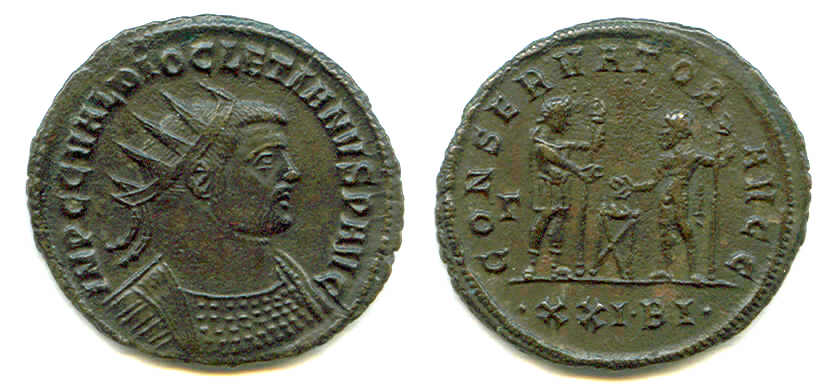
 [The obverse is the top image on this page]
[The obverse is the top image on this page]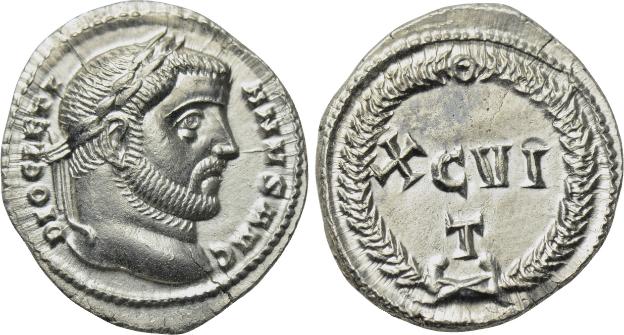
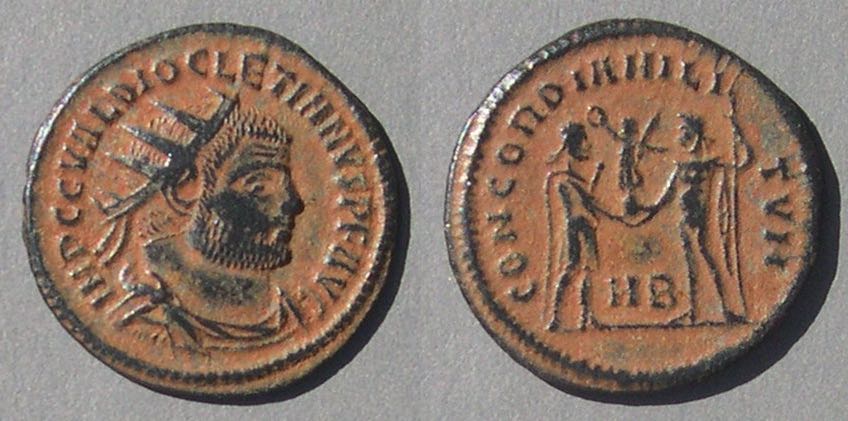
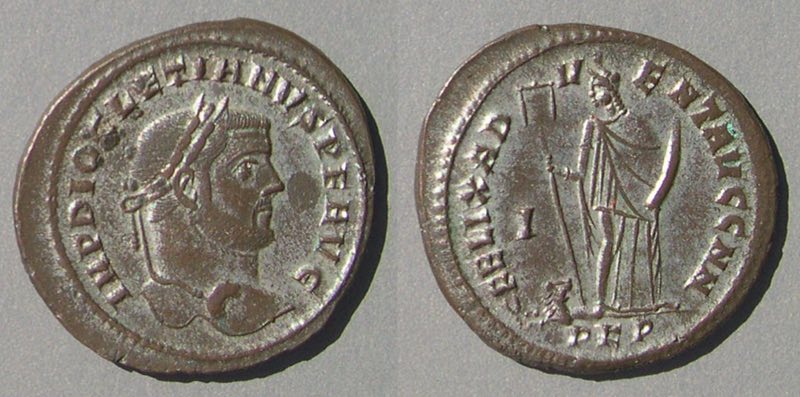 Diocletian
Diocletian
29-27 mm. 9.48 grams.
IMP DIOCLETIANVS PF AVG
FELIX ADVENT AVGG NN
Africa standing facing with elephant-skin headdress, holding standard and elephant tusk, tiny lion on bull at feet.
I in field (for Jove, the coins for Maximian have H for Hercules)
PKP in exergue (K is for Carthage)
RIC Carthage 23a "297-8."
Sear 12754. Failmezger 1.
Celebrates the happy arrival of Maximian at Carthage (with Diocletian included in the issue as Maximian's colleague).
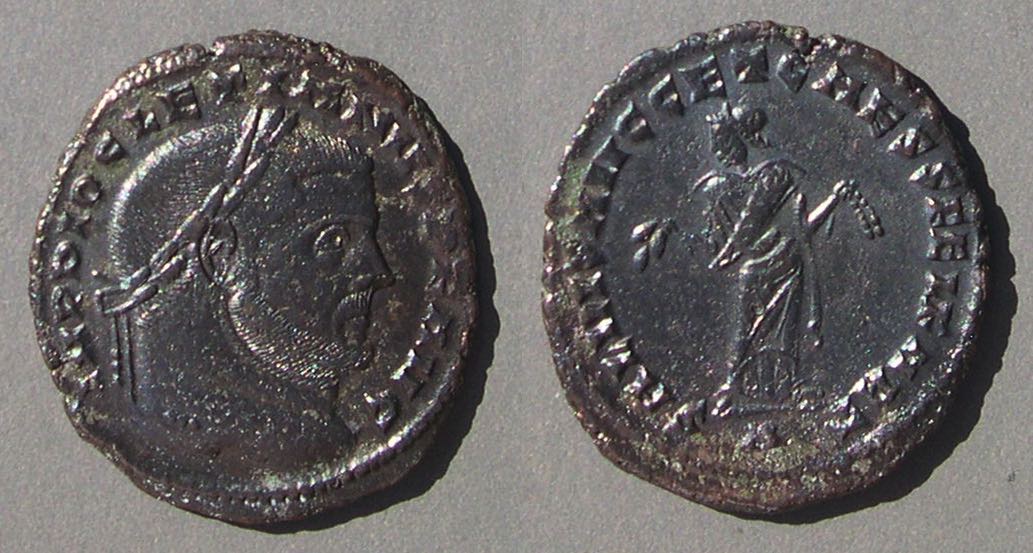
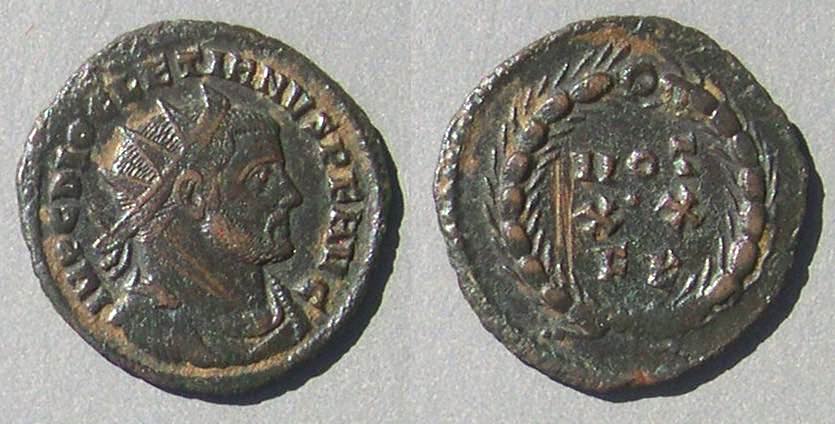
 Diocletian
Diocletian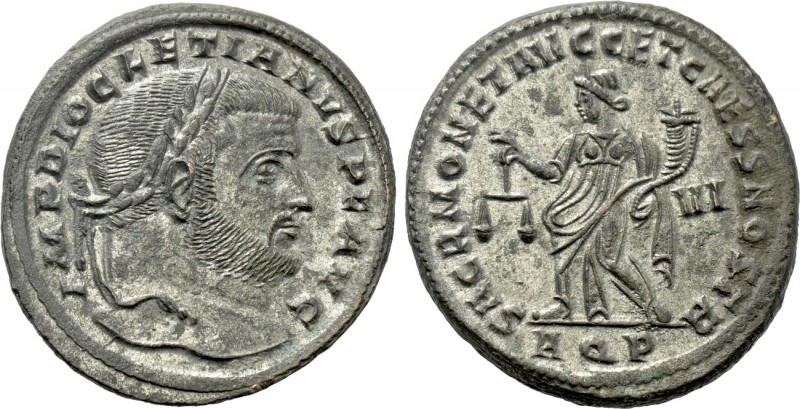
Diocletian
27 mm. 10.04 grams.
IMP DIOCLETIANVS PF AVG
SACR MONET AVGG ET CAESS NOSTR
Moneta holding a balance and cornucopia.
VI
AQP in exergue for Aquileia, officina Prima
RIC Aquileia 35a "c. 302-303."
Sear IV 12820. Failmezger 28.
This reverse design is the second-most common type of follis. It appears from five mints with numerous legend variants.
 Diocletian
Diocletian
Other types. It seems that almost every emperor minted a few unusual types that played almost no role in the monetary system. We wonder why they bothered and what the coins were good for. Here are two rare coins of unusual denominations.
![]()
Diocletian
22 mm. 4.12 grams.
IMP DIOCLETIANVS AVG
IOVI CONSERVATORI AVGG
RIC V.II 202, Rome, 285. "R3."
Sear 12830.
This laureate denomination is sometimes called an "as".
Why it was minted is not known.
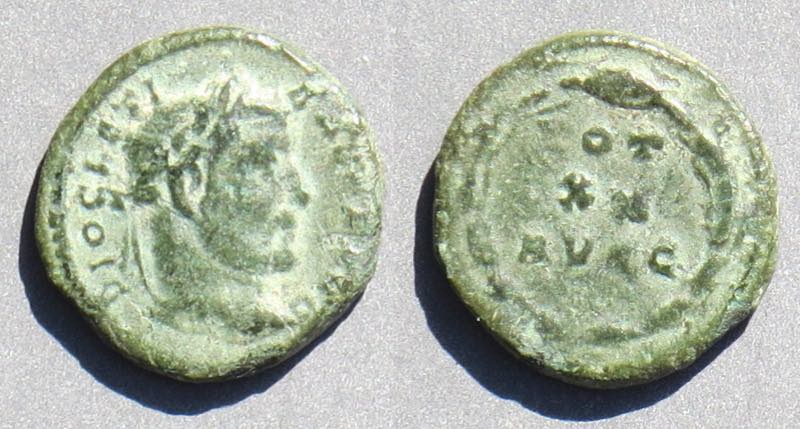 Diocletian
Diocletian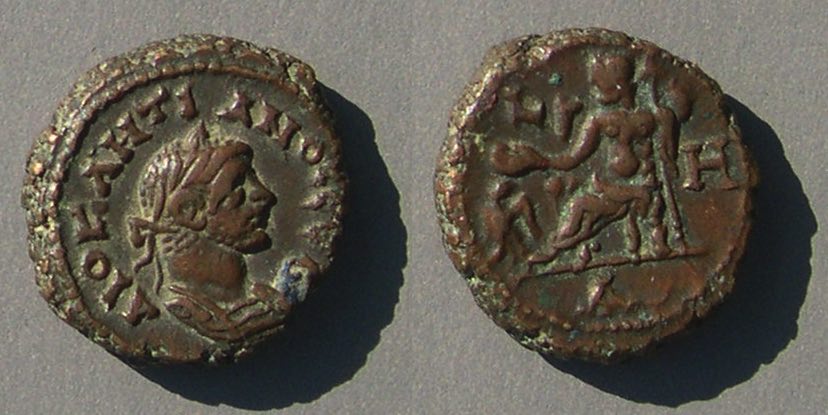 Diocletian
DiocletianHistory of Diocletian.
Diocletian becomes emperor. In 284 Carus was the senior Augustus and his two sons Carinus and Numerian were co-Augusti. Carus went east accompanied by Numerian, with Diocletian one of his generals, with plans to regain Mesopotamia from the Sasanians. Carinus stayed behind to take care of the rest of the empire. Carus successfully captured the Sasanian capital, Ctesiphon, but was later found dead in his tent after a thunderstorm. The romantic story is he was struck by lightning, however subsequent events suggest he was murdered by the praetorian prefect Arrius Aper. Numerian inherited the war and made peace on favorable terms. However, while returning from Mesopotamia he, too, was found dead. This time Aper was accused of murder and was executed. On the spot Diocletian was chosen emperor by the army. That left Carinus still Augustus in the west. After dealing with the usurper Julian of Pannonia, Carinus went east to confront Diocletian. The story is that Carinus was a womanizer and while Diocletian appeared to be losing a decisive battle with Carinus, Carinus was assassinated by an officer whose wife he had seduced. Diocletian inherited the empire.
Diocletian as Emperor. He is perhaps best known for voluntarily retiring (admittedly, after being quite ill) after a long reign of over twenty years. Much of Diocletian's impact was not because of glamorous wars, rather because of his dramatic changes of the day-to-day administration of the empire. Of course, he is famous for introducing the tetrarchy of four simultaneous rulers, but that is only the most visible (especially on coins!) of his many administrative changes that subdivided responsibilities. Diocletian dramatically increased the number of provinces by dividing old provinces into smaller regions and he separated their civil and military positions. This made it more difficult for any governor or general to command the resources to revolt. He reformed taxes by introducing an annual budget with fixed annual tax requirements on all parcels of land, according to their productivity, to be paid in kind, and on livestock and on people (a woman counted as half a man). Taxes had not been reformed for centuries, much valuable land had been untaxed, and taxes had been collected erratically with many rich people being able to evade them. His tax Edit of 297 was intended to raise more money for the state, but in a fair manner. Also, it hoped to reduce inflation by pegging taxes to goods instead of to gold and silver coins. (Later the system was abused by raising the tax requirements to impossible levels.) He required sons to take up the professions of their fathers--a very strict way to make sure that arable land retained farmers, armies had soldiers, and guilds had members. For example, if a man married the daughter of a miller, he was required to become a miller. Freedom was curtailed.
Modern markets rely on price incentives to shift supplies and people around to necessary and productive uses, but Diocletian and subsequent rulers saw that markets did not get the necessary jobs done, so they decreed they be filled by people who knew how to do them--the sons of people who had done them.
As usual, there were some wars with foreign adversaries. Conflicts with the Sasanians provoked a line of defensive forts on the eastern frontier; the remains of some are still visible in the eastern deserts.Diocletian's recognition that the empire was too large for one person to rule and the west and east each needed their own emperor turned out to be correct, even though Constantine was later able to unify the empire for a few years before it was again divided among his children.
When Diocletian retired in 305 and forced Maximian to retire with him, the Caesars became the new Augusti and two new Caesars were appointed, giving hope that the tetrarchic system would continue. However, when Constantius, a new Augustus of the Second Tetrarchy in the west, died in July 25, 306, the system of orderly succession of four rulers fell apart. Nevertheless, many of Diocletian's other administrative changes remained. Later rulers doubled down on Diocletian's methods of filling jobs and financing the government. His impact was long lasting.